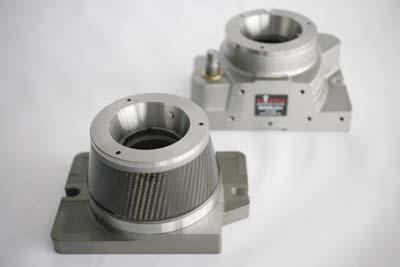
Higher productivity, lower energy consumption and offloading of the machine-drive are the highlights of the new carbon, ultra-light clamping devices that Hainbuch offers for machine tools. Thanks to the new material the new Carbon Fiber clamping devices are as much as two thirds lighter than the standard versions, however they are even stronger and more rigid – with identical clamping force values. By its nature, carbon fibre reinforced plastic is extremely light and extremely rigid, good reasons why to this point it has been primarily used in the aerospace industry and for various high-performance sports. However now Hainbuch has also discovered the advantages of this lightweight and optimized it for its purposes. The results are chucks that consist of multiple plastic fiber layers that are successively embedded in an epoxy resin matrix. A complex process that requires a lot of experience and even more finger-tip sensitivity. The result is impressive: The force-actuated TOPlus and the manually-actuated TOROK clamps open the new product series in the machine tool area of lightweight constructions. Users will be pleased and not just due to faster acceleration or delay of the machine spindle. Thanks to the faster machine cycle times, productivity is also increased. And in addition, thanks to the low-weight, energy consumption is low, set-up is extremely user-friendly, and the machine drive has a significantly lower load. And all this with increased strength and stiffness. Stationary it's also a good choice. The lightweight version of the manual-actuation MANOK plus stationary chuck is designed for implementation on milling machines and machining centers with low load weight. The aluminum flange, in conjunction with the Carbon Fiber base structure, allows a weight reduction of approximately 2/3 relatively to the standard version. In addition, the lightweight construction variant of the MANOK plus substantially minimizes the interference contour and offers impressive dynamic machining on 5-axis machines, and not just through low energy consumption and less centrifugal forces. Here as well the low weight offloads the machine drive and has a positive effect on positioning accuracy and user friendly set-up.
Contact Details
Related Glossary Terms
- centers
centers
Cone-shaped pins that support a workpiece by one or two ends during machining. The centers fit into holes drilled in the workpiece ends. Centers that turn with the workpiece are called “live” centers; those that do not are called “dead” centers.
- chuck
chuck
Workholding device that affixes to a mill, lathe or drill-press spindle. It holds a tool or workpiece by one end, allowing it to be rotated. May also be fitted to the machine table to hold a workpiece. Two or more adjustable jaws actually hold the tool or part. May be actuated manually, pneumatically, hydraulically or electrically. See collet.
- gang cutting ( milling)
gang cutting ( milling)
Machining with several cutters mounted on a single arbor, generally for simultaneous cutting.
- milling
milling
Machining operation in which metal or other material is removed by applying power to a rotating cutter. In vertical milling, the cutting tool is mounted vertically on the spindle. In horizontal milling, the cutting tool is mounted horizontally, either directly on the spindle or on an arbor. Horizontal milling is further broken down into conventional milling, where the cutter rotates opposite the direction of feed, or “up” into the workpiece; and climb milling, where the cutter rotates in the direction of feed, or “down” into the workpiece. Milling operations include plane or surface milling, endmilling, facemilling, angle milling, form milling and profiling.
- stiffness
stiffness
1. Ability of a material or part to resist elastic deflection. 2. The rate of stress with respect to strain; the greater the stress required to produce a given strain, the stiffer the material is said to be. See dynamic stiffness; static stiffness.
